Deadheading flowers is an essential gardening practice that can dramatically enhance the beauty and productivity of your garden. By removing spent blooms, you encourage new growth, promote continuous flowering, and maintain the overall health of your plants.
Whether you’re a seasoned gardener or just starting out, this comprehensive guide will provide you with everything you need to know about deadheading, from the basics to advanced techniques. Discover the benefits, methods, and best practices for keeping your flowers thriving and your garden bursting with color.
Definition of Deadheading
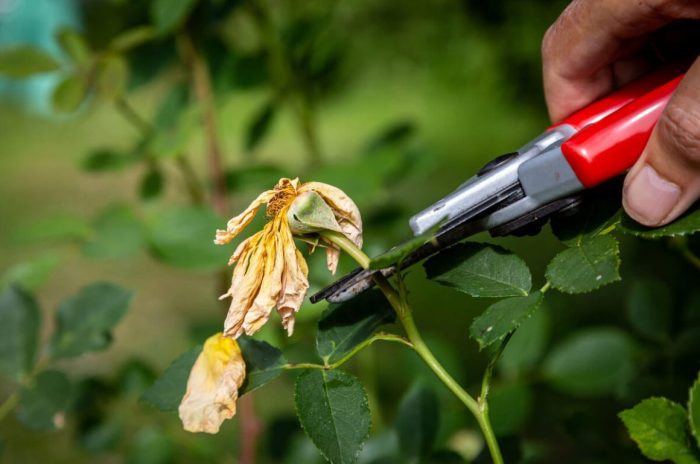
Deadheading, a common gardening technique, involves removing spent or faded flowers from plants. It’s a crucial practice that promotes plant health, enhances aesthetics, and prolongs blooming.
By removing dead flowers, you prevent the plant from wasting energy on seed production. Instead, the plant can redirect its resources towards producing new flowers, foliage, and roots. Deadheading also improves air circulation around the plant, reducing the risk of diseases and pests.
Purpose of Deadheading
- Promotes continuous blooming by encouraging the plant to produce more flowers.
- Enhances plant appearance by removing unsightly spent flowers.
- Prevents seed production, which can weaken the plant and reduce flowering.
- Reduces the risk of disease and pests by improving air circulation.
Benefits of Deadheading
- Healthier plants with increased vigor and productivity.
- Continuous display of vibrant and colorful flowers.
- Reduced need for replanting or replacing annuals.
- Improved overall garden aesthetics.
Methods of Deadheading
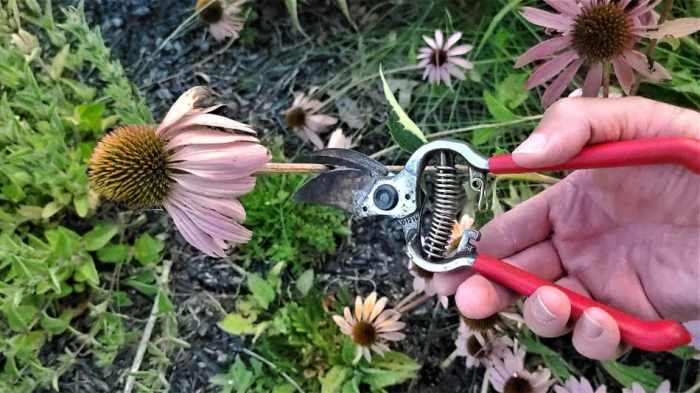
Deadheading is a crucial gardening technique that promotes continuous blooming and enhances the overall health of your plants. There are various methods of deadheading, each with its own advantages and applications.
The most common methods of deadheading include:
Pinching
Pinching is a simple and effective method for deadheading small flowers and annuals. Simply use your thumb and forefinger to pinch off the spent blooms, removing them at the base of the flower stem. This method is particularly useful for plants that produce clusters of small flowers, such as petunias and geraniums.
Cutting
For larger flowers and woody plants, cutting is a more appropriate method. Use sharp, clean shears or a knife to cut off the spent blooms. Make the cut just above a leaf node or a side shoot, where new growth can develop.
Deadheading with a Tool
For plants with particularly large or stubborn blooms, you can use a specialized deadheading tool. These tools are designed to make clean cuts and minimize damage to the plant. Simply insert the tool into the flower head and twist or pull to remove the spent bloom.
Types of Flowers Suitable for Deadheading

Deadheading is a technique that can significantly improve the health, appearance, and productivity of many types of flowers. It involves removing spent blooms and faded flowers to encourage new growth and flowering. Deadheading is particularly beneficial for certain types of flowers with specific growth habits and flowering patterns.
Annual Flowers
Annual flowers complete their life cycle within a single growing season. They typically produce a profusion of blooms throughout the summer and benefit from regular deadheading. Removing spent blooms prevents the plant from putting energy into seed production, encouraging it to produce more flowers.
Some examples of annual flowers suitable for deadheading include:
- Petunias
- Marigolds
- Zinnias
- Impatiens
- Cosmos
Perennial Flowers
Perennial flowers live for multiple years and can benefit from deadheading to extend their blooming period and improve their overall health. Deadheading perennial flowers encourages the plant to produce new stems and flowers, resulting in a longer and more vibrant display.
Some examples of perennial flowers suitable for deadheading include:
- Daylilies
- Salvia
- Coneflowers
- Astilbe
- Phlox
Shrubs
Some types of shrubs also benefit from deadheading to encourage new growth and flowering. Deadheading shrubs involves removing spent blooms and pruning back stems to promote bushier, more compact growth. Some examples of shrubs suitable for deadheading include:
- Hydrangeas
- Roses
- Buddleia
- Forsythia
- Weigela
By identifying the types of flowers that benefit from deadheading and understanding their specific growth habits and flowering patterns, gardeners can effectively utilize this technique to enhance the beauty, productivity, and overall health of their plants.
Troubleshooting Common Issues
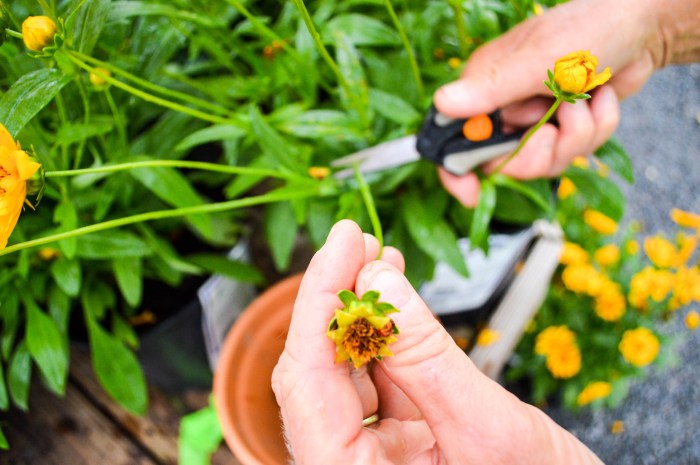
Deadheading is generally a straightforward process, but occasionally, gardeners may encounter some common problems. Here are a few potential issues and tips for resolving them:
Stems Breaking During Deadheading
Cause
Using blunt tools or pulling stems too forcefully can cause them to snap.
Solution
Use sharp, clean shears or pruners and make precise cuts close to the flower head. Avoid pulling or yanking the stems.
Deadheading flowers, the act of removing spent blooms, is a crucial task in maintaining a vibrant backyard. Not only does it improve the overall aesthetics, but it also encourages the plant to produce more blooms. By removing the dead flowers, the plant’s energy is redirected towards producing new buds, resulting in a longer and more bountiful blooming season.
Plants Wilting After Deadheading, Deadheading flowers
Cause
Removing too many flowers at once can stress the plant and lead to wilting.
Solution
Deadhead only a few flowers at a time and avoid removing more than 1/3 of the total blooms. Water the plant deeply after deadheading to help it recover.
Pest or Disease Problems
Cause
Deadheading can create open wounds on plants, making them vulnerable to pests or diseases.
Solution
Sterilize tools before and after use to prevent the spread of pathogens. Avoid deadheading when plants are wet, as this can increase the risk of infection. If pests or diseases do occur, treat them promptly according to the specific problem.
Just as you deadhead flowers to encourage new blooms and keep your garden looking its best, you can also give your concrete patio a little TLC to keep it looking spick and span. While you may be tempted to reach for the pressure washer, there are actually gentler methods that can get the job done just as well.
Head over to how to clean concrete patio without pressure washer for some easy tips on how to clean your patio without the hassle. After all, a clean and well-maintained patio is the perfect place to enjoy the outdoors and deadhead your flowers to your heart’s content.
Failure to Bloom Again
Cause
Deadheading too late in the season or removing too much foliage can prevent plants from producing new blooms.
Solution
Deadhead spent blooms as soon as possible after they fade and avoid removing healthy foliage. Follow the recommended deadheading time for specific plant species.
Additional Tips and Considerations
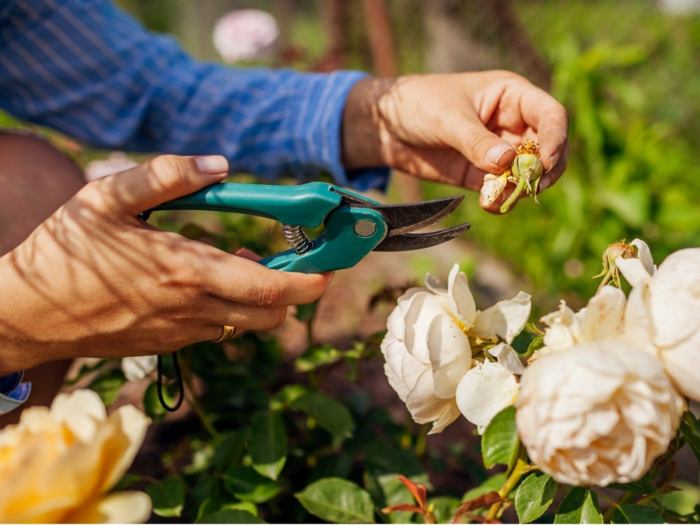
Deadheading is a simple but effective way to promote healthy plant growth and extend the blooming period. Here are some additional tips and considerations to enhance your deadheading practice:
Choose the right tools:Use sharp, clean pruners or scissors to avoid damaging the plant. Make clean cuts at a 45-degree angle, just above a leaf node or lateral bud.
Deadhead regularly:Regular deadheading encourages new growth and flowering. Remove spent blooms as soon as they appear, but avoid over-deadheading, which can weaken the plant.
Consider plant species:Different plant species have varying deadheading requirements. Some plants, like roses, benefit from regular deadheading, while others, like poppies, should only be deadheaded sparingly.
Consider growing conditions:Deadheading may need to be adjusted based on growing conditions. In hot, dry climates, deadheading can help reduce water loss through transpiration.
Deadheading for Specific Plant Species
- Roses:Deadhead regularly to encourage new blooms and prevent disease.
- Perennials:Deadhead to promote bushier growth and prevent self-seeding.
- Annuals:Deadhead to extend the blooming period and prevent seed formation.
- Bulbs:Deadhead after flowering to allow the plant to store energy for next season.
Considerations for Specific Gardening Conditions
- Hot, dry climates:Deadhead more frequently to reduce water loss.
- Cool, moist climates:Deadhead less frequently to prevent excessive growth.
- Container gardening:Deadhead more frequently to promote air circulation and prevent disease.
Outcome Summary: Deadheading Flowers
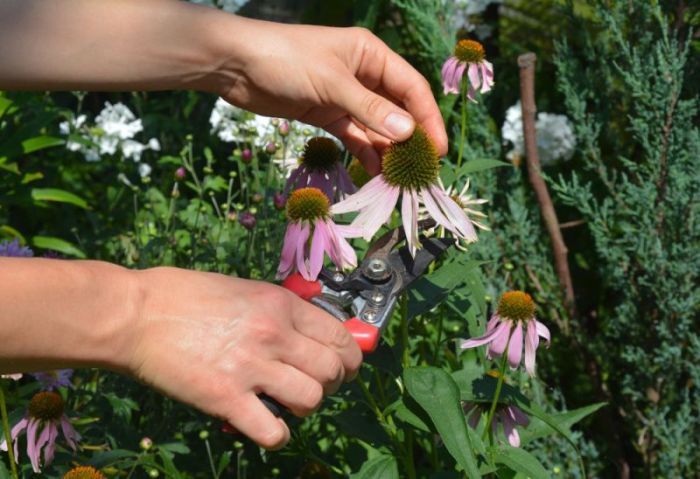
Incorporating deadheading into your gardening routine is a simple yet transformative practice that will reward you with a vibrant and flourishing garden. By understanding the principles and techniques Artikeld in this guide, you can unlock the full potential of your flowers, ensuring they bloom to their fullest and bring joy to your outdoor space for seasons to come.